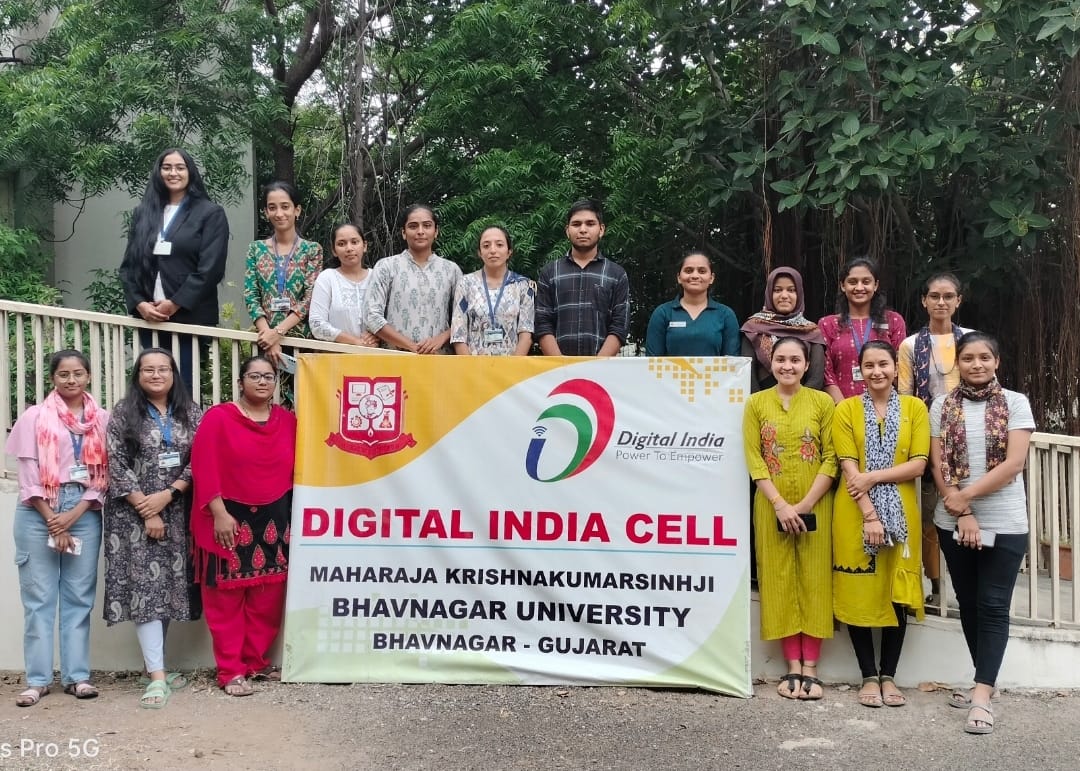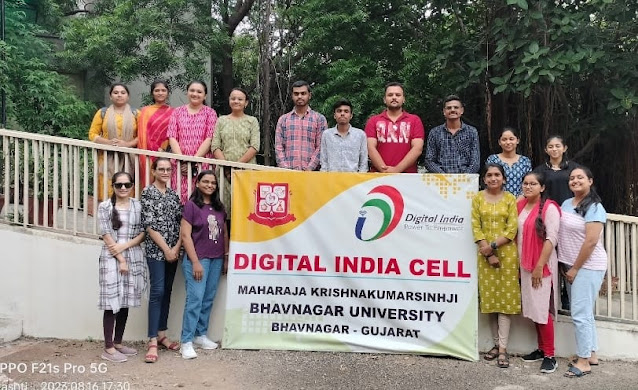Elocution/Debate Competition Workshop Organized by Maharaja Krishnakumarsinhji Bhavnagar University
Communication serves as a vital tool for interacting with others, but mastering effective communication skills is essential. Speaking is an art that requires careful cultivation.
Recently, MK Bhavnagar University organized a series of workshops aimed at training and preparing students for the upcoming Youth Festival. These workshops covered a wide range of competitions including Elocution, Debate, Folk Dance, Folk Music, Performative Art, Painting, Photography, Cartooning, Clay Modeling, Paper Collage, and more. Experts in each respective field were invited to guide students on the rules, techniques, and strategies for excelling in these events. The dates of August 25th and 27th were particularly enlightening for me, as I participated in the Elocution and Debate workshop, which spanned two days. We were privileged to have Ashish Shukla sir as our expert guide for mastering the art of elocution.
On the first day, Mahendrasinh Parmar sir, the head of the Gujarati department, introduced us to the basics of elocution and debate. He candidly delved into the nuances of language required for elocution competitions. One prime focus was language precision. An illustrative instance involved correcting the pronunciation of the term "વકૃત્વ," where the correct articulation is "વક+તૃત્વ," and not "વકૃ+ત્વ." This correction highlighted the need for linguistic precision in elocution competitions. While minor mispronunciations are acceptable in everyday discourse, they can significantly impact the quality of elocution. Additionally, he explored three overarching aspects of language communication: Reception, Perception, and Expression. He underscored the fundamental importance of clear language and pronunciation in elocution, which is essentially an art form of speech.
During the initial phase of the workshop's first day, we were instructed to step onto the stage and provide a basic introduction encompassing our names, institution name, subject specializations, and the reasons for attending this specific workshop. This exercise was not just about introducing ourselves but also aimed to uncover how we express our thoughts. While the entire workshop was conducted in the Gujarati language, the principles and guidelines were universally applicable to all languages used in elocution competitions.
Subsequently, our instructor Ashish Shukla sir took charge of the workshop. On the very first day, he laid the foundation by providing a comprehensive understanding of the competition. He emphasized six key aspects:
1. સમય (Time): Highlighting the significance of managing time effectively during speeches.
2. વિષય (Subject): Stipulating the importance of selecting an appropriate and engaging topic.
3. વિષયવસ્તુ (Content): Emphasizing the content's relevance and quality in delivering a compelling speech.
4. ઉચ્ચાર (Pronunciation): Focusing on correct pronunciation for clarity and impact.
5. રજૂઆતની છટા (The way of expression): Highlighting the manner in which thoughts are expressed, emphasizing eloquence.
6. ભાષા પ્રયોજન (Language usage): Stressing the importance of effective language use in conveying ideas accurately.
Once these foundational concepts were established, Ashish Shukla sir introduced us to a selection of 13 potential subjects before our lunch break. Our task was to choose one subject from this list and prepare a 3-minute speech to be delivered after the lunch break. The subjects provided included:
1. ભારતનો અમૃતકાળ: અપેક્ષા અને અવરોધો (India's Age of Immortality: Expectations and Obstacles)
2. પર્યાવરણ જાળવણી : વૈશ્વિક પડકારો (Environmental Conservation : Global Challenges)
3. ખરેખર કુદરત કિફારી રહી છે? (Is Nature Really Vindictive?)
4. ચંદ્રયાન 3 ની સફળતા : અંતરીક્ષ વિજ્ઞાનમાં ભારતની હરણફાળ (Success of Chandrayaan 3: India's Breakthrough in Space Science)
5. પૂર્વોત્તર ભારતની સમસ્યાઓ અને સમાધાન (Problems and Solutions of Northeast India)
6. રાષ્ટ્રીય શિક્ષણ નીતિ કેટલી નવી ? (How New is the National Education Policy?)
7. સમાન નાગરિક ધારો: મારા વિચારો (Uniform Civil Code: My Thoughts)
8. AI: વરદાન કે અભિશાપ ? (AI: Boon or Curse?)
9. રાષ્ટ્રપ્રેમના માપદંડો : કેટલા સાચા? કેટલા પોકળ? (Criteria of Patriotism: How True? How Hollow?)
10. આજની યુવાપેઢી દિશાહીન છે? (Is Today's Youth Directionless?)
11. સ્થાનિક ઉત્પાદન ક્ષેત્રે આપણે કેટલા આત્મનિર્ભર? (How Self-Sufficient Are We in Local Production?)
12. સ્વરોજગારી: કઈ ઉમરથી? કેટલી અનિવાર્ય? (Self-Employment: From What Age? How Much Necessary?)
13. સ્ટુડન્ટ સ્ટાર્ટ અપ: એક નવતર પ્રયોગ (Student Start-Up: A Novel Experiment)
Following the break, we were allotted time to prepare for our respective speeches. Each of us had to select a subject and ready ourselves to speak for three minutes. This was the beginning of our practical learning journey, allowing us to identify our shortcomings and recognize areas that needed improvement. Moreover, the constraint of time added an additional layer of challenge.
Following each participant's turn, our instructor provided us with invaluable feedback and tips. Among the advice shared were:
1. Thoughtful Topic Selection: Prioritize selecting a unique topic. When opting for commonly chosen subjects like "Environment," strive to introduce a fresh perspective or explore an untouched angle.
2. Engaging Beginnings and Endings: Craft impactful introductions and conclusions that capture the audience's attention and leave a lasting impression.
3. Clarity of Topic Understanding: Begin with a concise overview of the topic, ensuring that your audience comprehends the subject's context and significance.
4. Intonation and Expression: Avoid a flat tone which can be monotonous; instead, employ variations in your voice to maintain audience engagement. Adjust your voice to emphasize key points, drawing the audience into your discourse.
5. Eye Contact: Establish and maintain eye contact with your audience while speaking. This connection enhances your credibility and involvement with the listeners.
6. Language Clarity and Pronunciation: Emphasize clear language and precise pronunciation to ensure your message is conveyed effectively.
7. Microphone Usage: Refrain from holding the microphone while speaking. This advice, initially shared by Mahendrasinh Parmar sir, was to eliminate unconscious gestures that can distract from your speech.
8. Regional Dialect: Acknowledge the influence of regional dialects. While it's advisable to minimize their use, if your speech includes such nuances, consider embracing them as a unique strength.
These invaluable lessons constituted the foundation of our first day's learning. We were tasked with refining our speeches on the same topics for presentation on the following day.
On the second day, we had the privilege of Dr. Hiral Joshi ma’am's presence, a plasma research scientist and an alumni of the university, having studied at Sir P. P. Institute of Science. Notably, she had win the Youth Festival Elocution thrice during her graduation. Her accomplishments made her a remarkable source of inspiration and guidance for us. During this session, she encouraged us to introduce ourselves in novel ways, allowing for diverse expressions of identity.
Following this insightful interaction, the final session commenced, during which we presented the speeches we had meticulously prepared. Ashish Shukla sir was also present to oversee the proceedings. One of the most rewarding aspects of this session was that Dr. Hiral Joshi ma’am provided individual advice and tips to each student after their speech.
Here are the key points she underscored:
Preparation is Paramount: Never step onto the stage without adequate preparation.
Precise Beginning: Initiate with a concise and precise opening. Then swiftly transition to the main content to maximize the effectiveness of your speech within the allotted time.
Body Language: The use of appropriate body language complements your verbal expression and enhances the impact of your speech.
Justified Conclusion: Your speech's conclusion should aptly justify the subject matter discussed.
Source Authenticity: Ensure that official information shared in your speech is credible. Rely on reputable and authentic sources, preferably from reliable websites.
Conviction: Transmit your conviction effectively, allowing your passion for the subject to resonate with your audience.
Stay Updated: Stay updated with current events and trends to incorporate relevant and contemporary elements in your speech.
Maintain Flow: Avoid monotony by maintaining a dynamic flow in your speech. Prevent it from becoming flat or predictable.
Chronology and Relevance: Organize your speech chronologically and maintain relevance throughout.
Stay on Topic: Avoid straying from the subject. Keep your discourse focused and concise, akin to a magnifying lens.
Innovative Content: Infuse novelty into your speech, surprising the audience with fresh insights or perspectives.
Thorough Research: Delve into in-depth research to enrich your speech with comprehensive information and depth.
Convincing the Audience: Your speech should convince the audience of its value, making them feel that your words are worth both listening to and contemplating.
On August 26th, the valedictory function for all the workshops took place. Each event and workshop learning were showcased during this event. Remarkably, the Elocution team, including myself, had the opportunity to host the function. This chance was graciously provided by Ashish Shukla sir, with the intention of honing our public speaking skills. This valedictory function featured diverse events, including performances such as Folk Songs, Sugam Git, Duha Chhand, Play performances under Performative Art, Folk Dance, and speeches and experience sharing from various workshops.
My Learning Outcome:
Reflecting on my learning journey, I've been participating in elocution competitions since a very young age, starting around the 3rd standard. My foray into public speaking began in the 5th standard. Unfortunately, the past three years of my graduation coincided with the COVID-19 pandemic, which deprived me of the opportunity to participate in the youth festival. Despite this setback, I remained engaged in elocution competitions within the college context and even took on roles as an event host.
Participating in this workshop provided a chance to either learn anew or perhaps relearn valuable speaking skills. When the topics were assigned, I chose to delve into the subject of "AI: Boon or Curse?" On the initial day of the workshop, my expression and speaking style were in excellent form. However, there seemed to be a misalignment between the subject matter and the criteria set forth by our instructor. On the following day, I successfully managed to bridge this gap. Dr. Hiral Joshi ma’am praised my clarity of communication and the effectiveness with which my thoughts resonated with the audience. This experience also led me to observe a transformative shift in my role as a speaker.
During the valedictory function, I was granted the honor of hosting the opening segment, which included introductions and the rendition of the University song. What struck me most was a newfound allure I discovered within myself when speaking. Although I had always been open to addressing audiences at events, this workshop imparted a fresh charm to my speaking style.
I extend my heartfelt gratitude to Ashish Shukla sir, our instructor, Mahendra Parmar sir, and Dr. Hiral Joshi ma’am for their illuminating guidance in honing the art of speaking. Their insights have undoubtedly enriched my speaking skills and imbued me with a renewed passion for effective communication.
Throughout the workshop's duration, the university offered lunch to all participants. Thanks to the University for conceptualizing diverse workshops, enabling students to acquire essential skills under the guidance of experts.
I hope that you've taken pleasure in reading about my workshop experience and that you've found it worth reading. Thank you for taking the time to visit and engage with my learning.






































.png)
.png)






.png)


